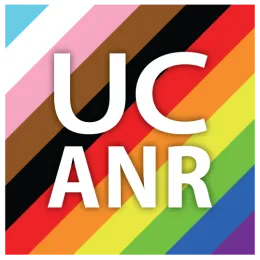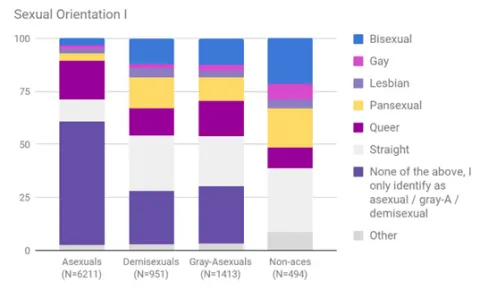 What is asexuality and aromanticism?
What is asexuality and aromanticism?

Definition
Asexuality is the lack of sexual attraction to others. It is not at all related to a person’s behavior – it’s an orientation, not a choice. Sometimes people mistakenly assume asexuality is like celibacy or abstinence. On the contrary, asexual people can, and do, engage in relationships of all sorts. Someone who is asexual may refer to themselves as “ace.” Ace is an umbrella term that also includes people who identify as aromantic. There have been very few studies to characterize the U.S. asexual population, but there are estimates that anywhere from 0.1% to 1.5% of the general population is asexual.
This figure from Bauer et al. 2015 shows how people within the asexual community often also identify as another orientation within the LGBTQ+ umbrella.

Aromanticism refers to a person’s lack of romantic attraction to others. Like asexuality, it isn’t related to someone’s behavior. Aromantic people also engage in many kinds of relationships, including queerplatonic relationships. Someone who is aromantic may refer to themselves as “aro.” About 26% of asexual people also identify as aromantic.
Are asexuality and aromanticism “new” identities?
Although asexuality and aromanticism are not as widely discussed as some of the other identities within the LGBTQ+ umbrella, they have been documented around the world in various ways since at least the 1860s. The Coordinating Council of New York Radical Feminists released an Asexual Manifesto (the original version is not screen-reader or dyslexia friendly) in 1972. Many of these historical documents focus on white asexual women. There is less visibility for asexual men and nonbinary folks, and even less for asexual people of color.
With the help of forums and social media since the early 2000s, the asexual community and its visibility grew rapidly in online spaces. Only recently has the scientific community begun to explore experiences and patterns more thoroughly among the ace and aro communities. As the community became more visible, ace and aro individuals also became the targets of online and in-person harassment and physical and sexual assault (content warning for mentions of rape). Asexual Awareness Week, occurring in late October, began in 2010 to encourage broader awareness and celebration.
Resources
The following items provide some insights.
Articles:
The Asexual Visibility and Education Network (AVEN) FAQ for Family/Friends
AVEN introduction to Romantic orientations
Essay from Michael Paramo: “The Asexual Community is Predominantly White. Why?”
Wikipedia, “Timeline of Asexual History”
Videos:
Laci Green and David Jay: “No Sex?! – Asexuality” (3m55)
Yasmin Benoit on asexual representation in media (6m10s)
Multiple speakers on being aromantic (4m13s)
As you engage with the resources above, we invite you to reflect:
If this is your first time hearing about the asexual and aromantic community, why do you think it is?
What are you learning about this community?
How will you use your new knowledge to help make ANR more inclusive?
Want to keep learning? Check out these additional LGBTQ+ resources.
